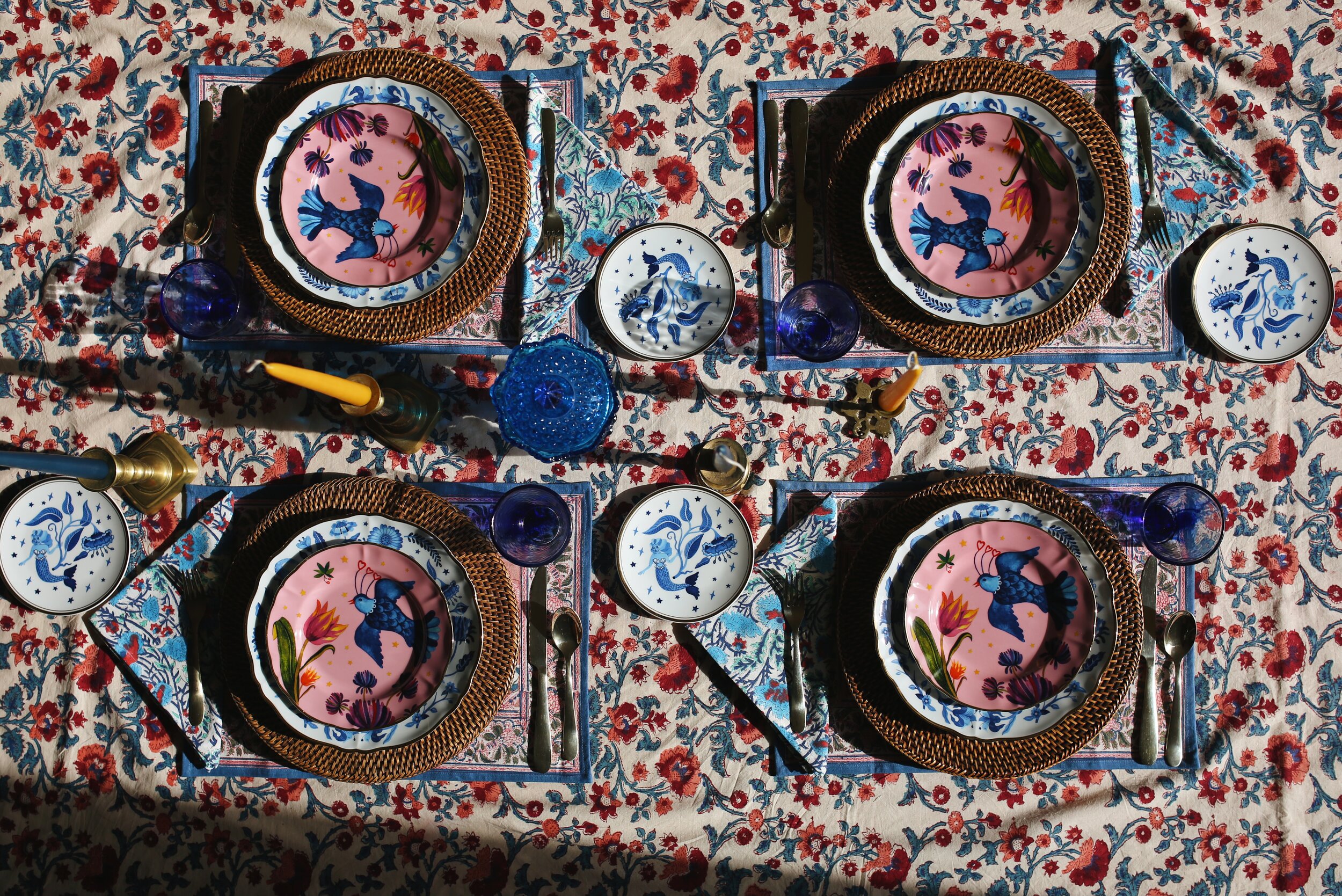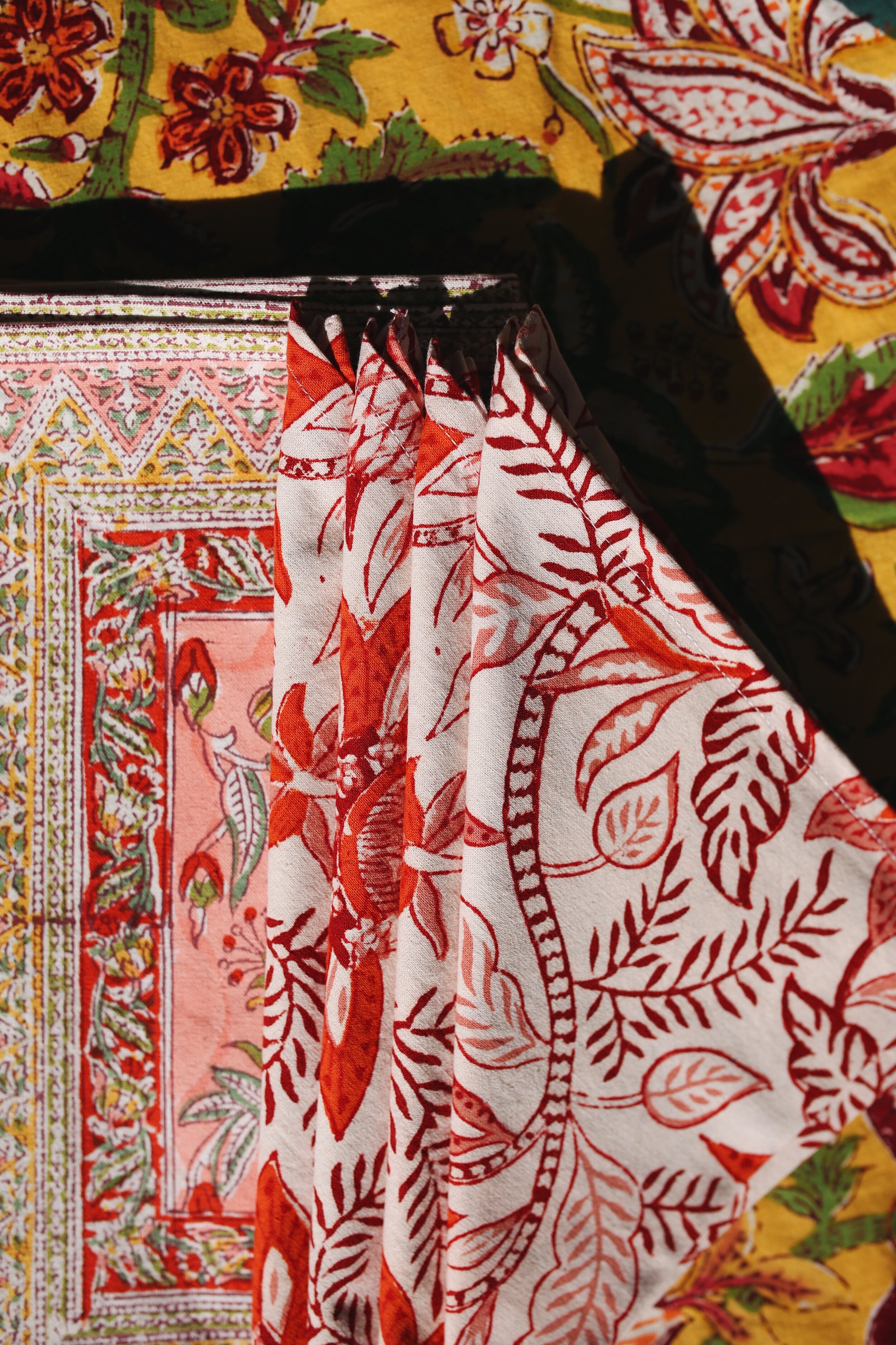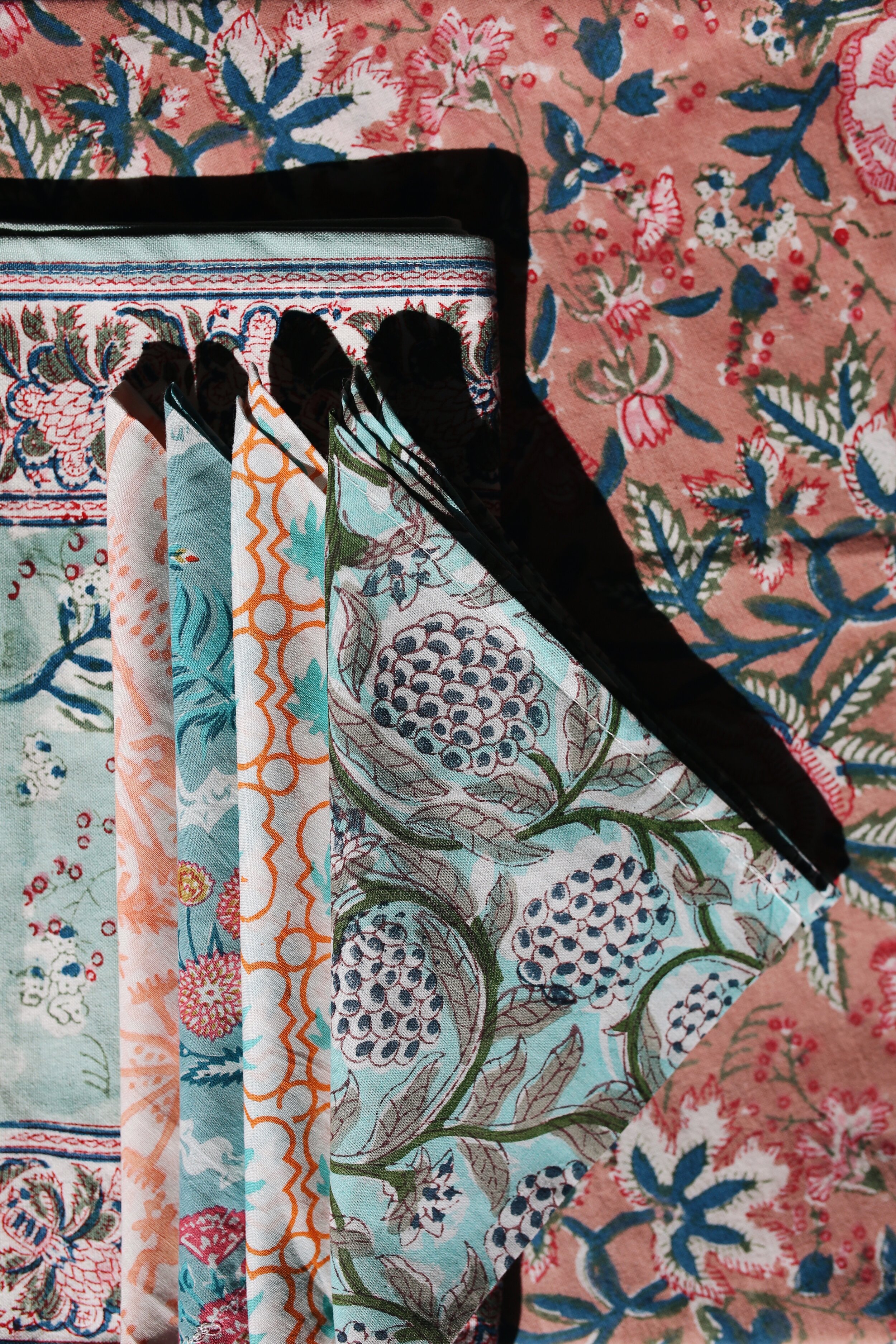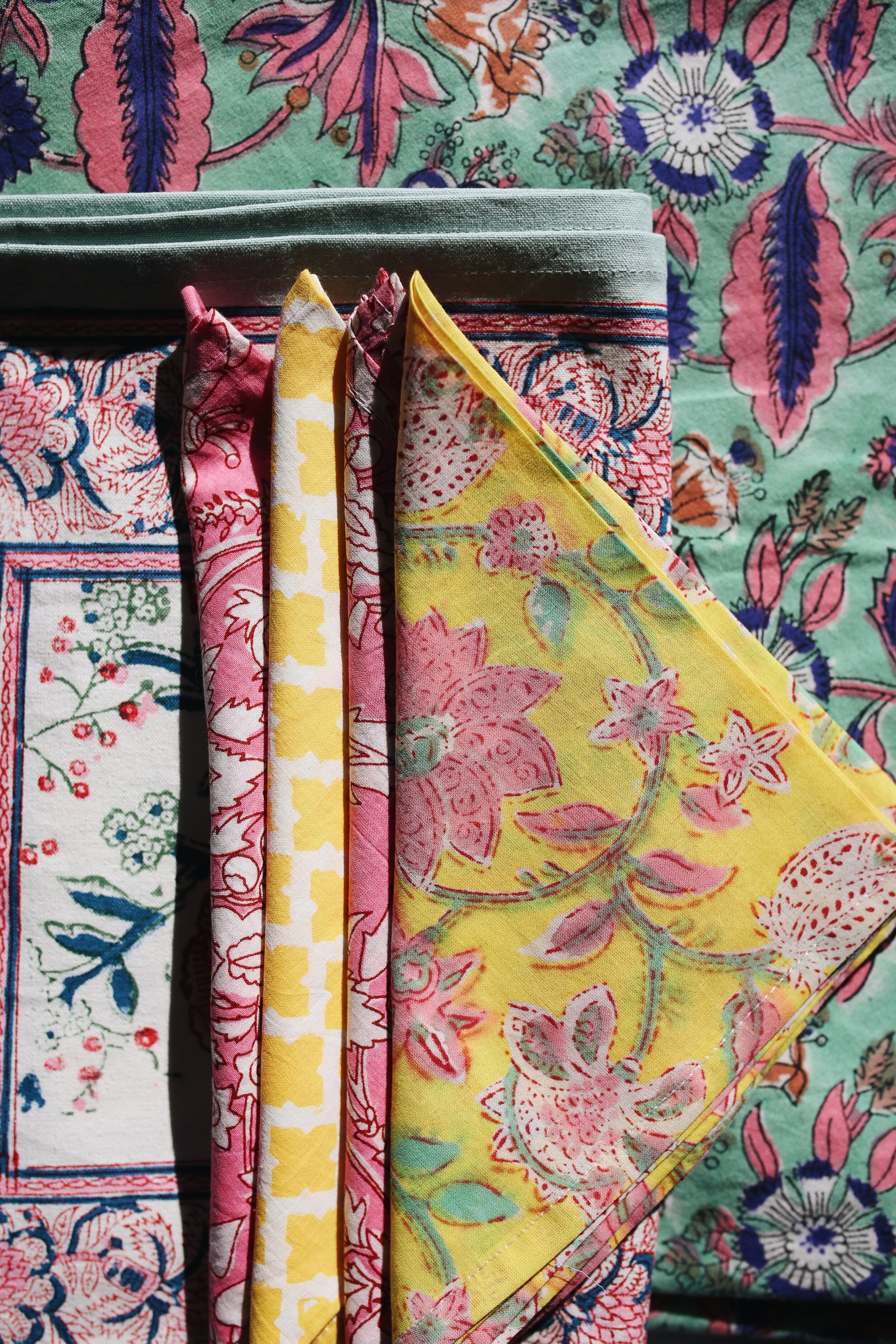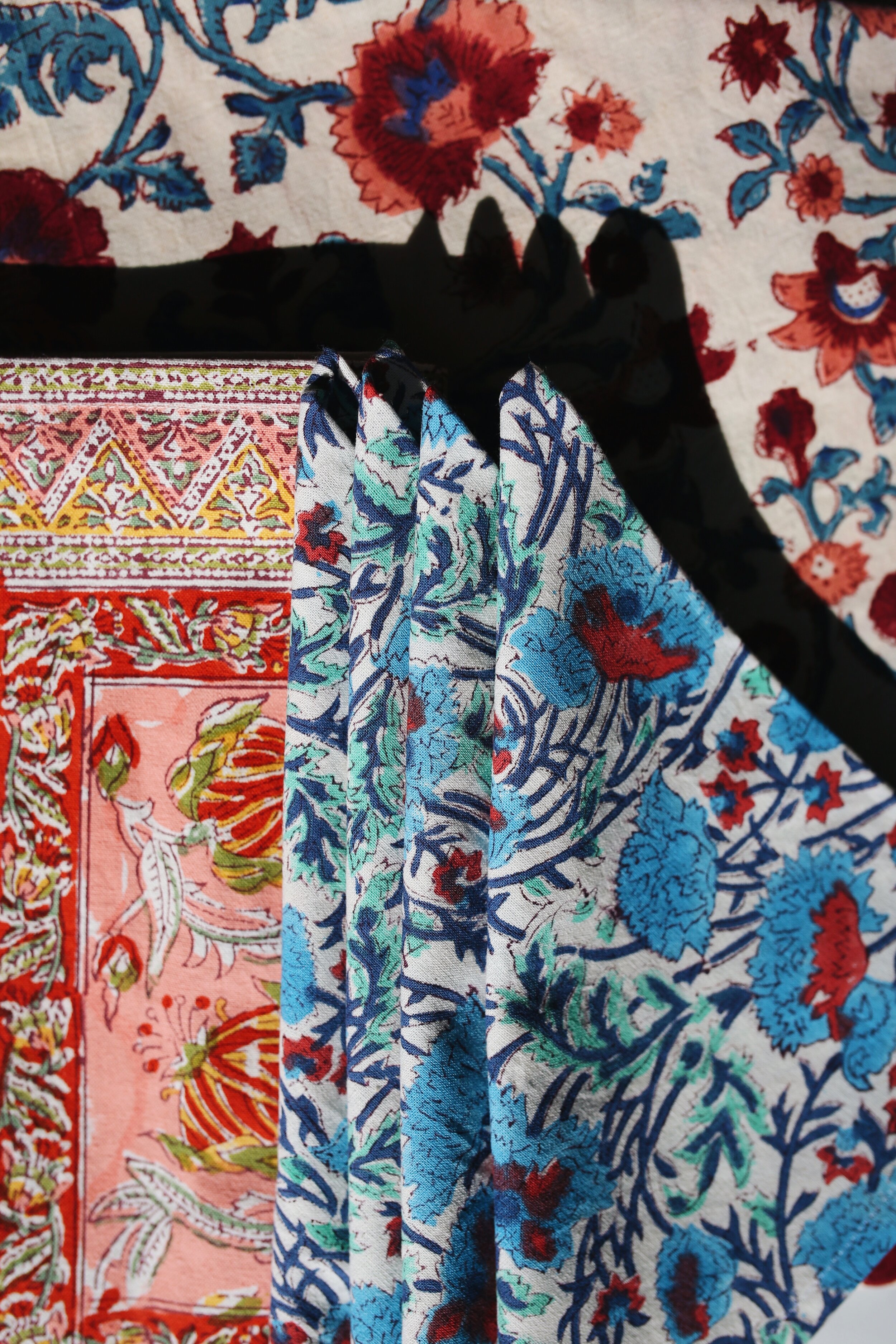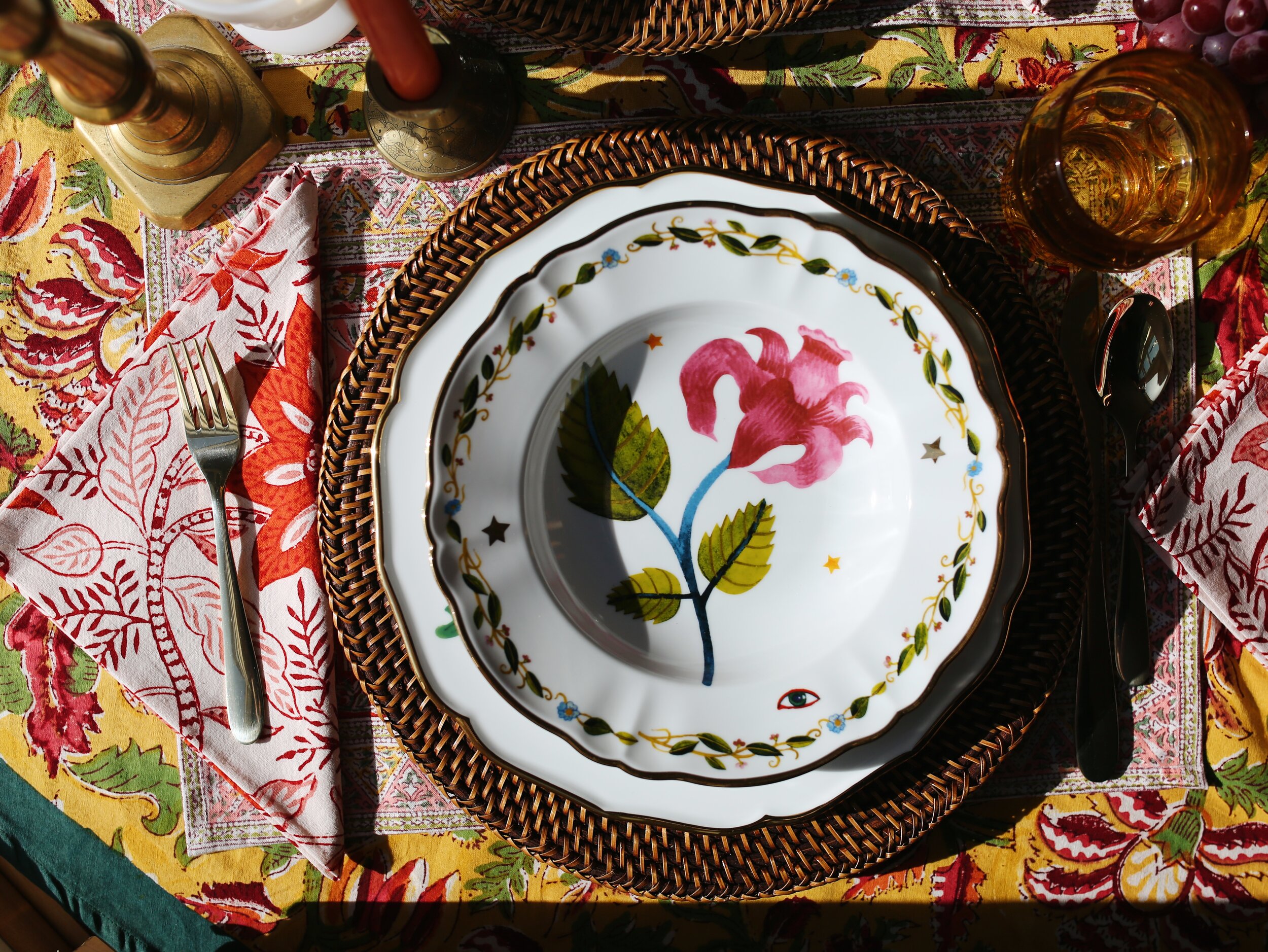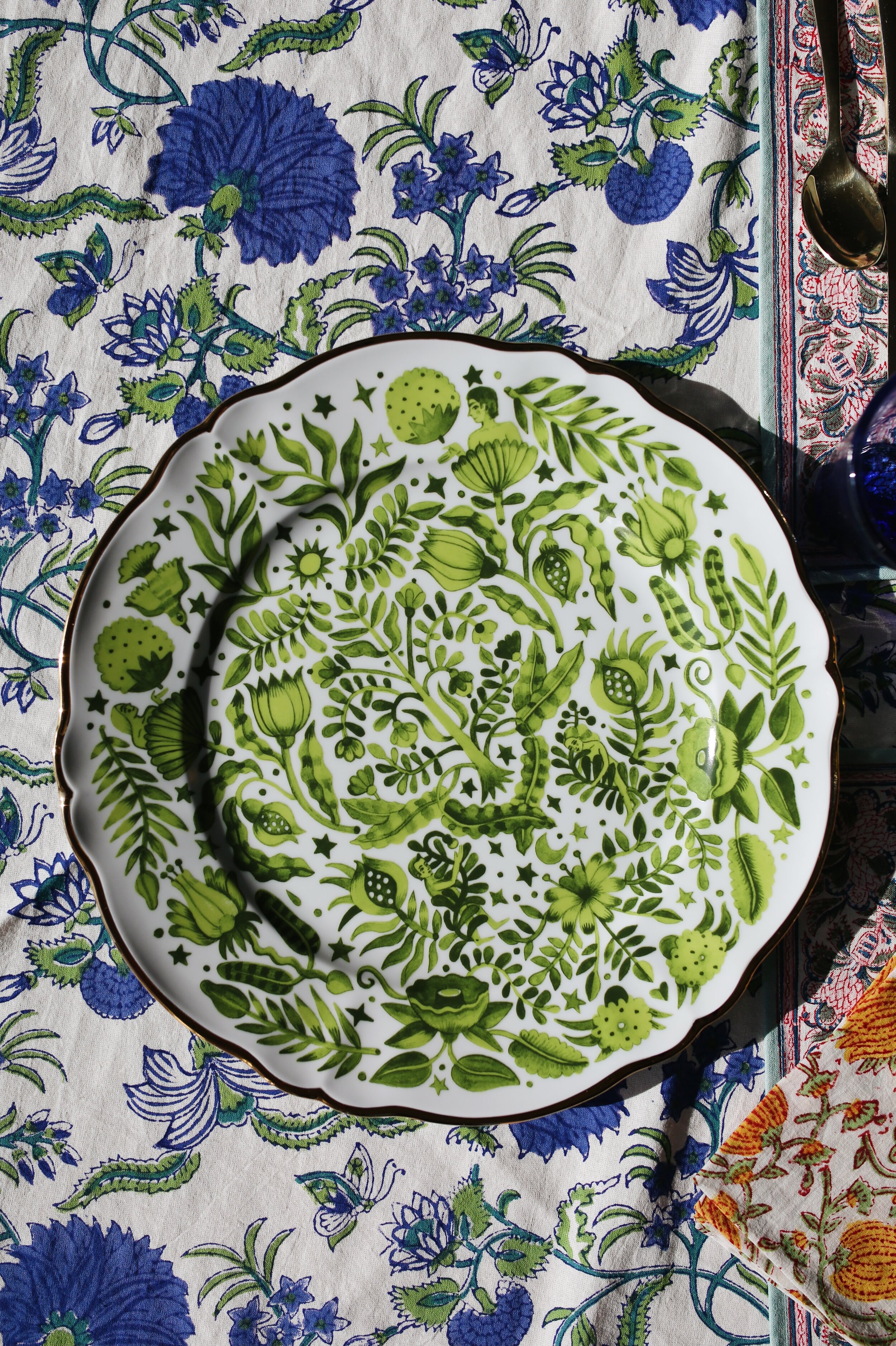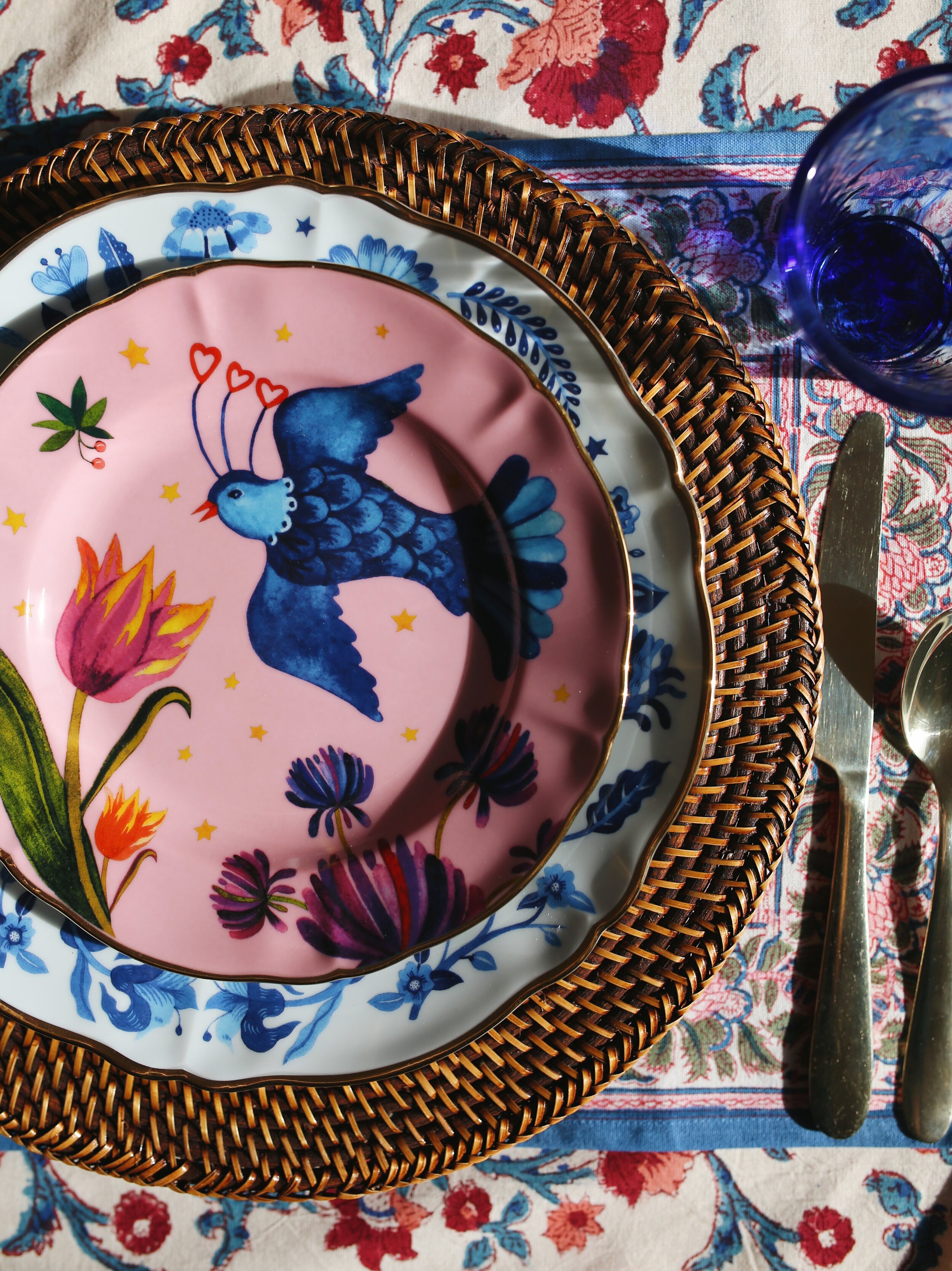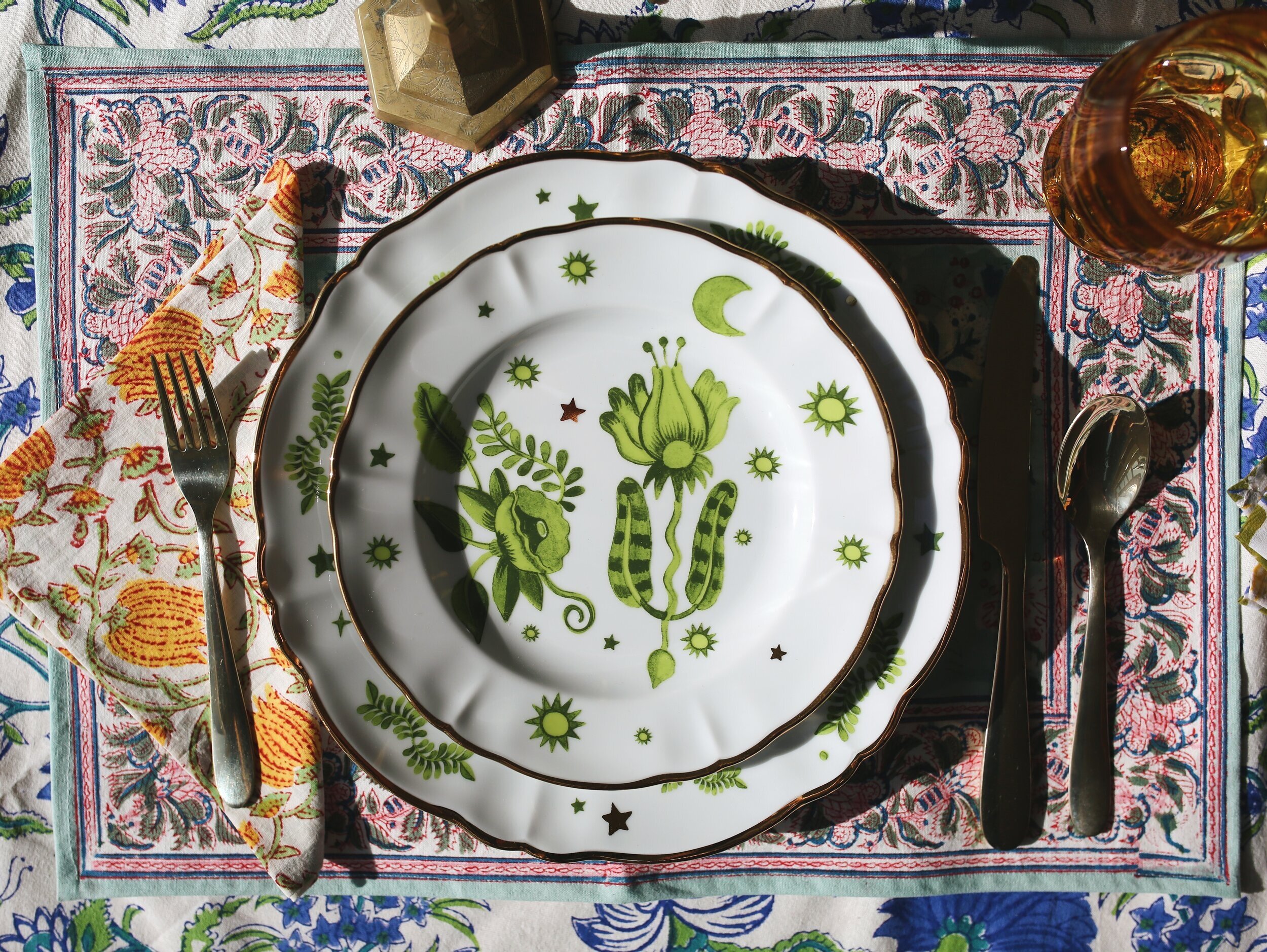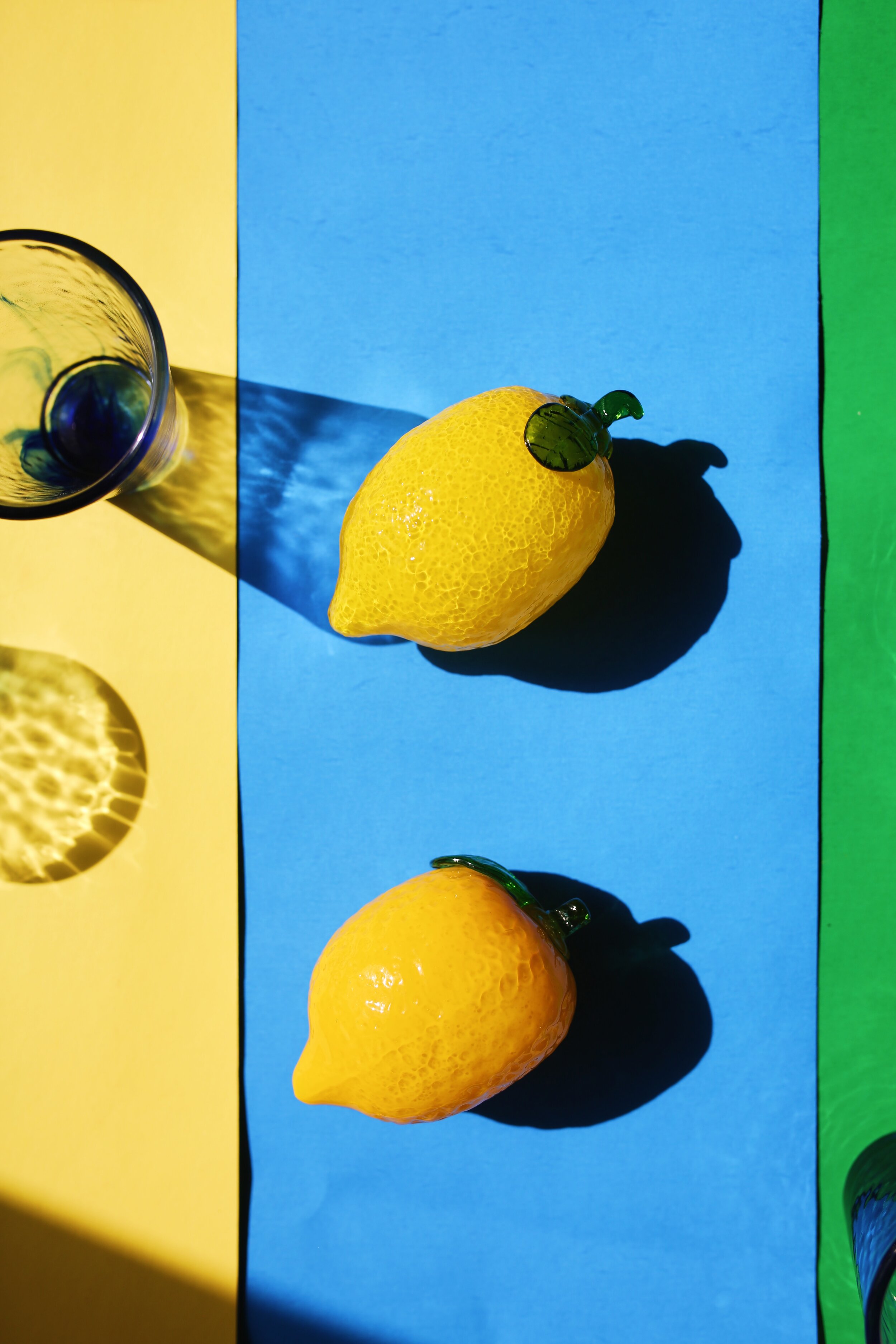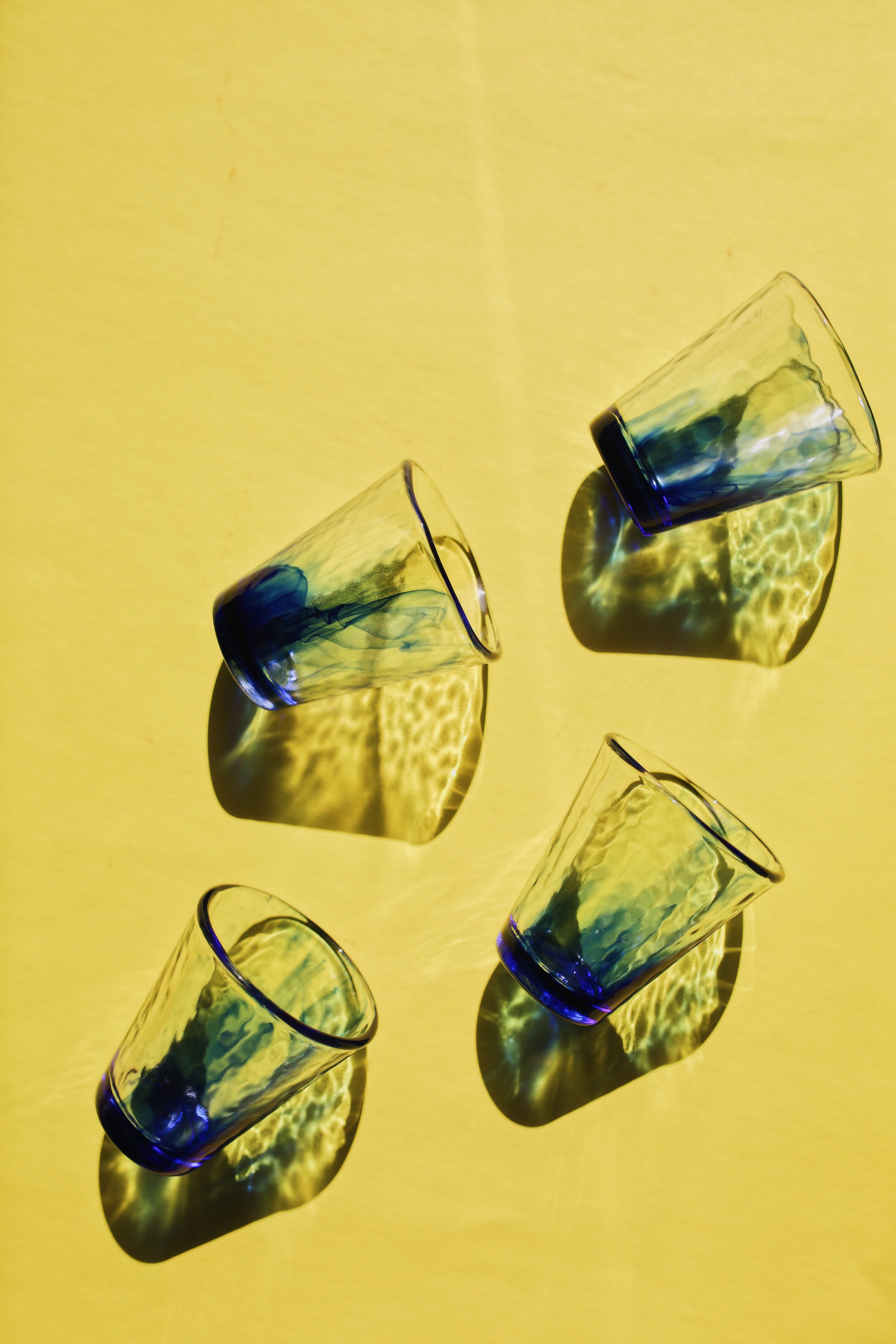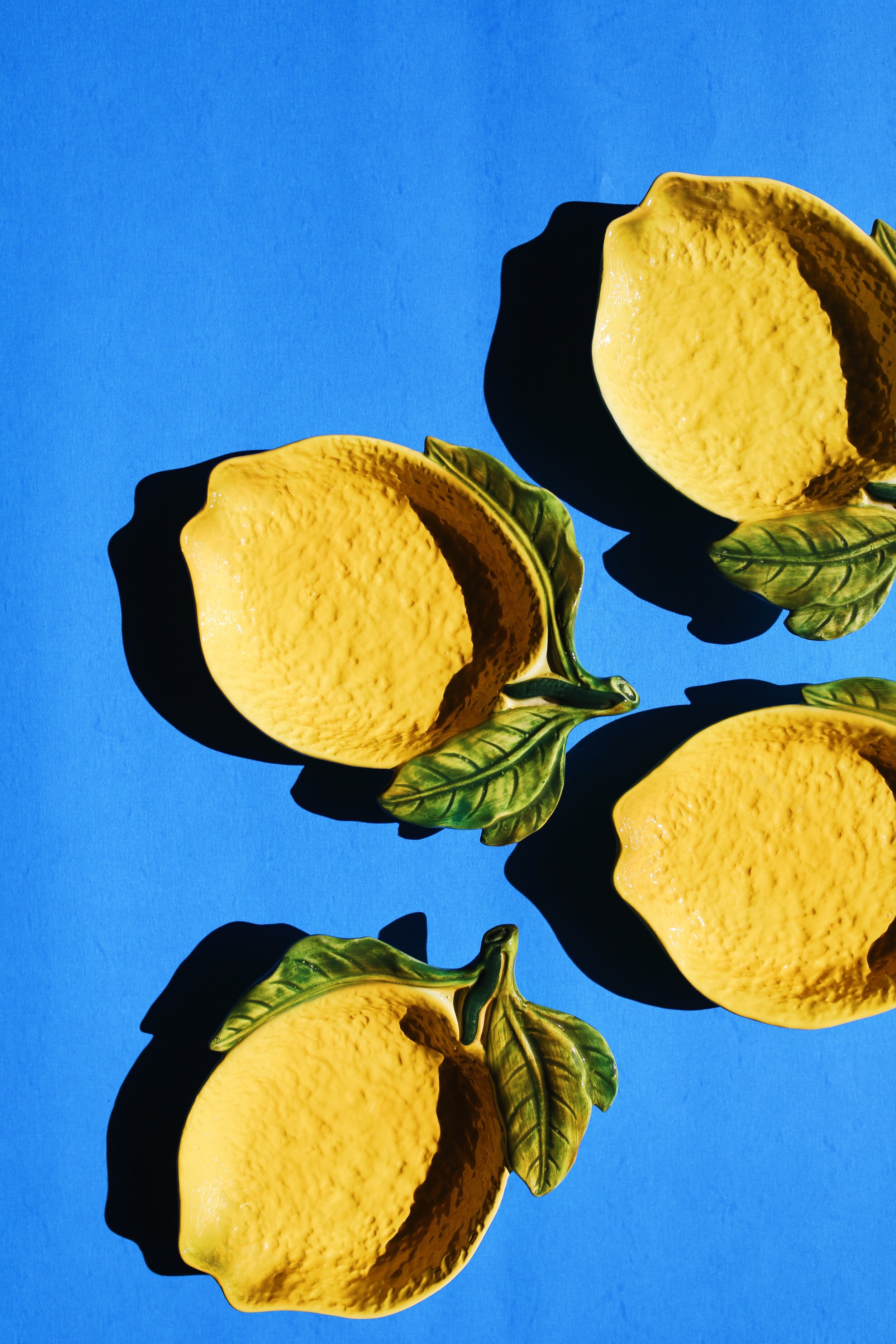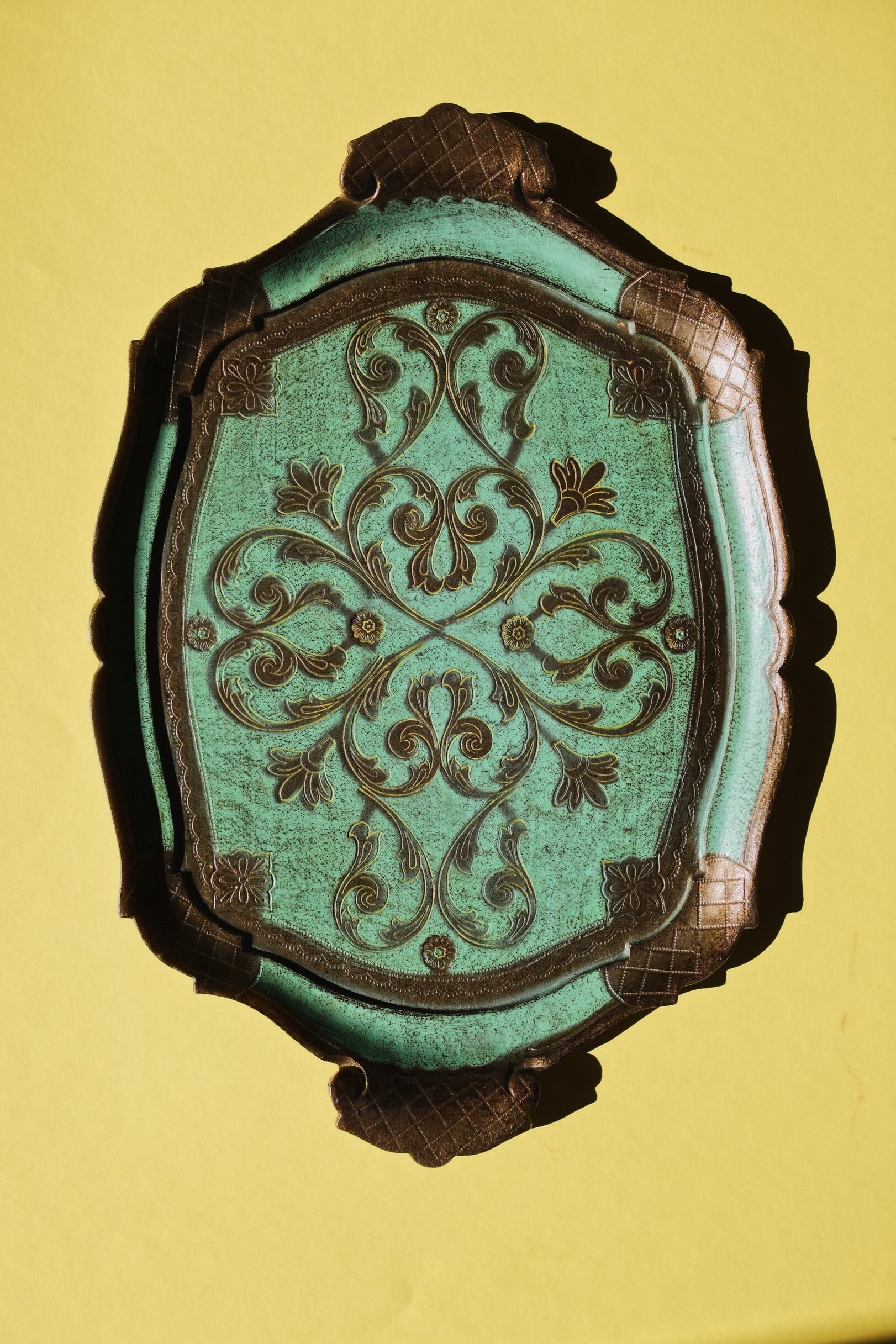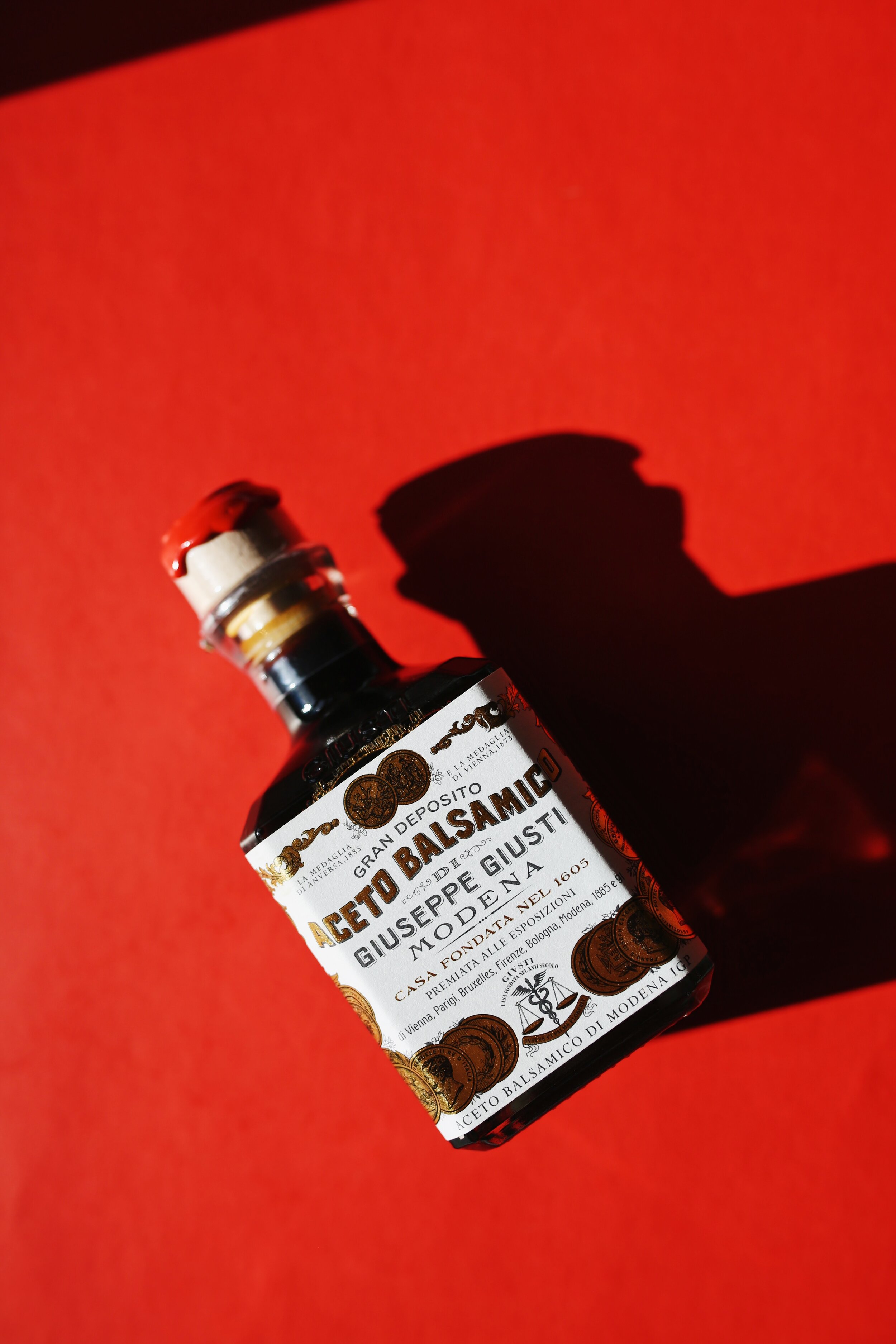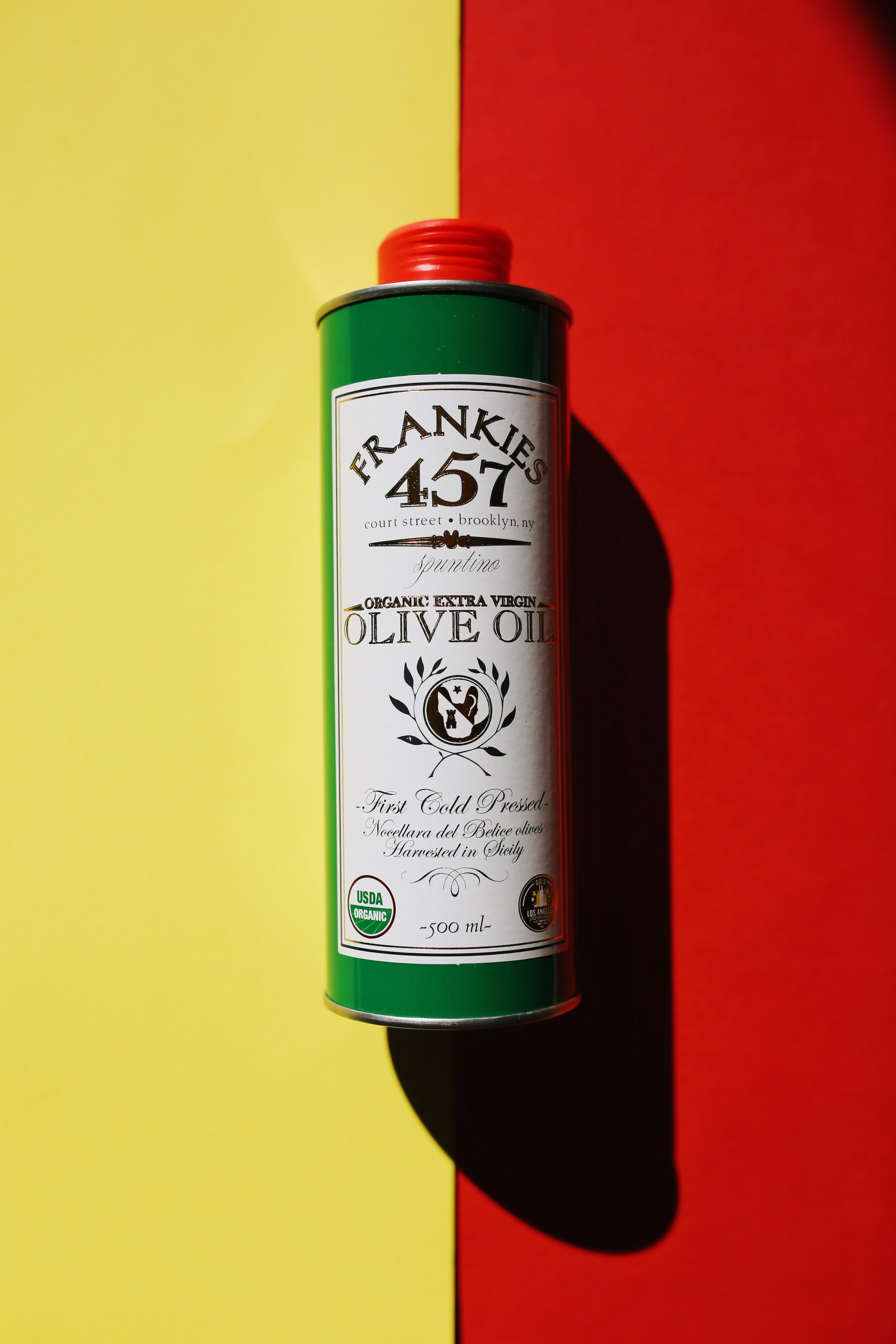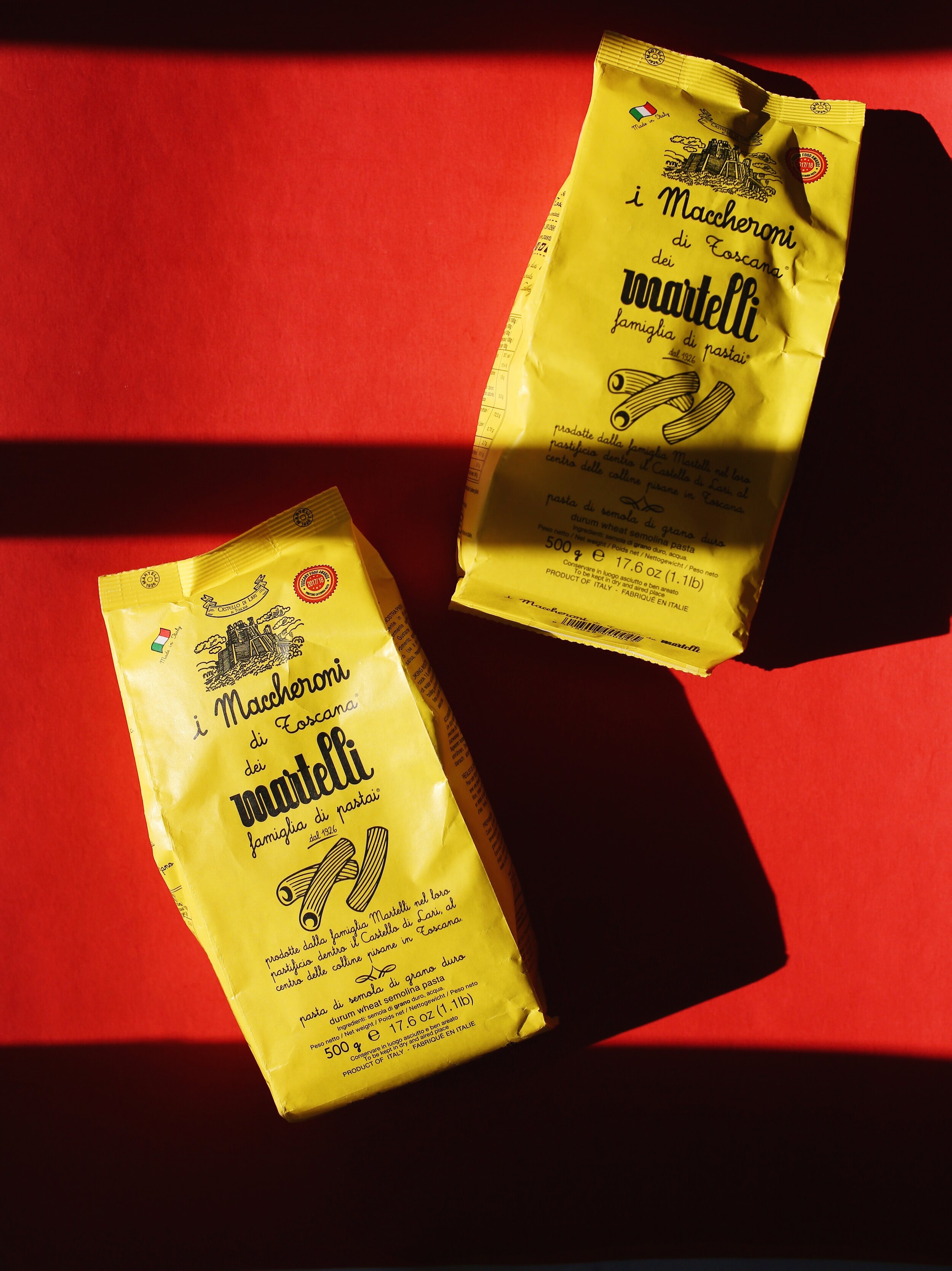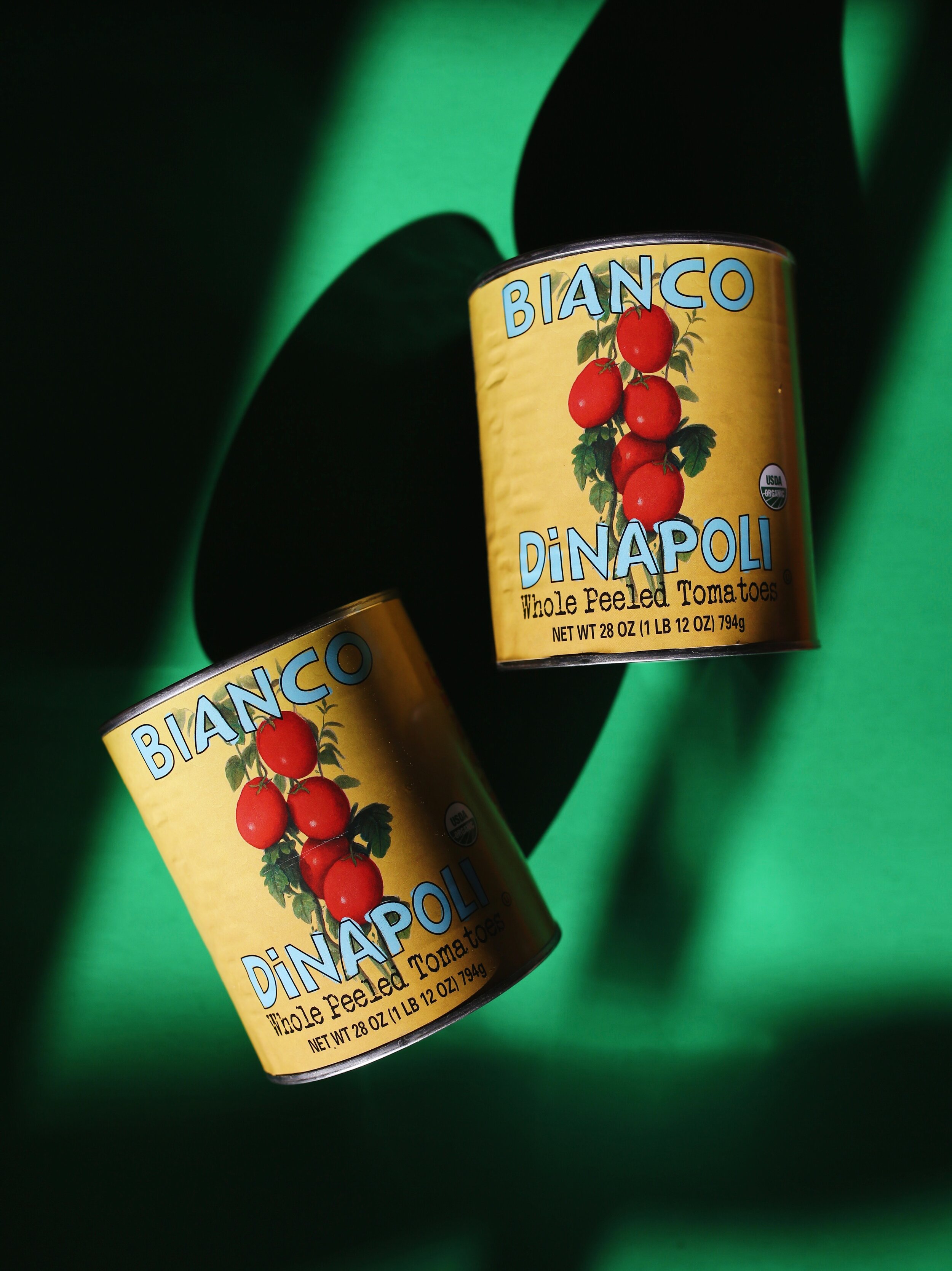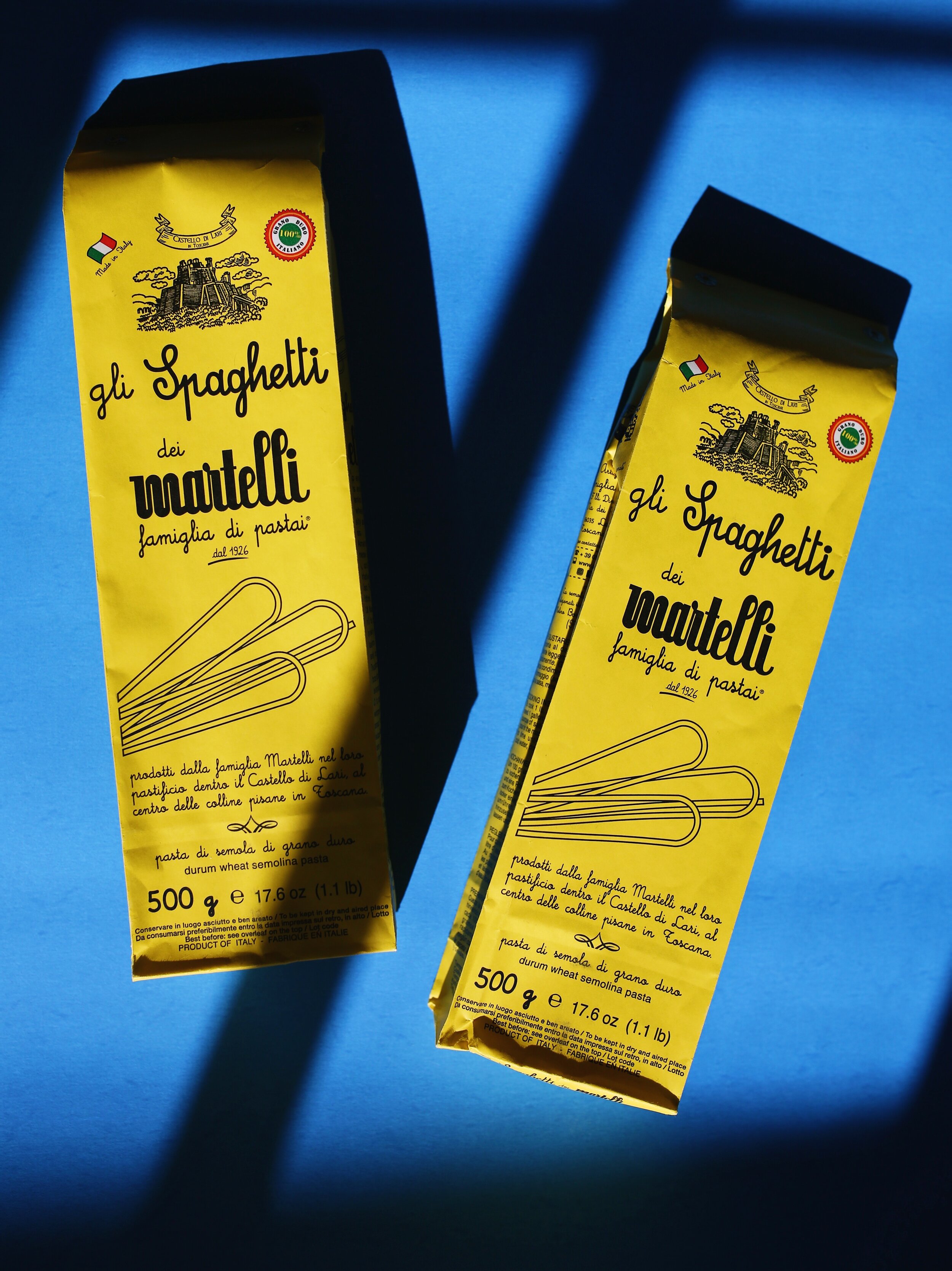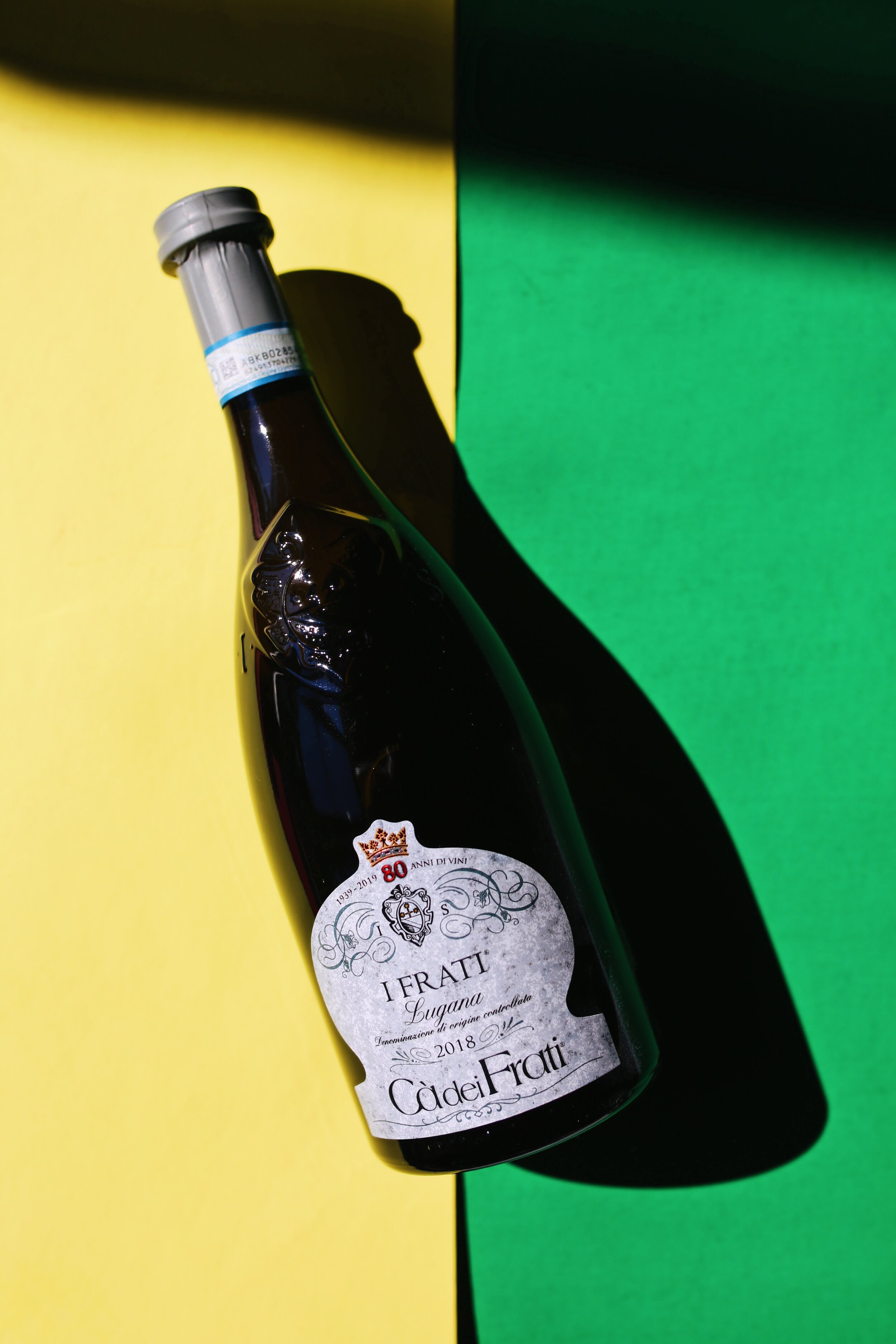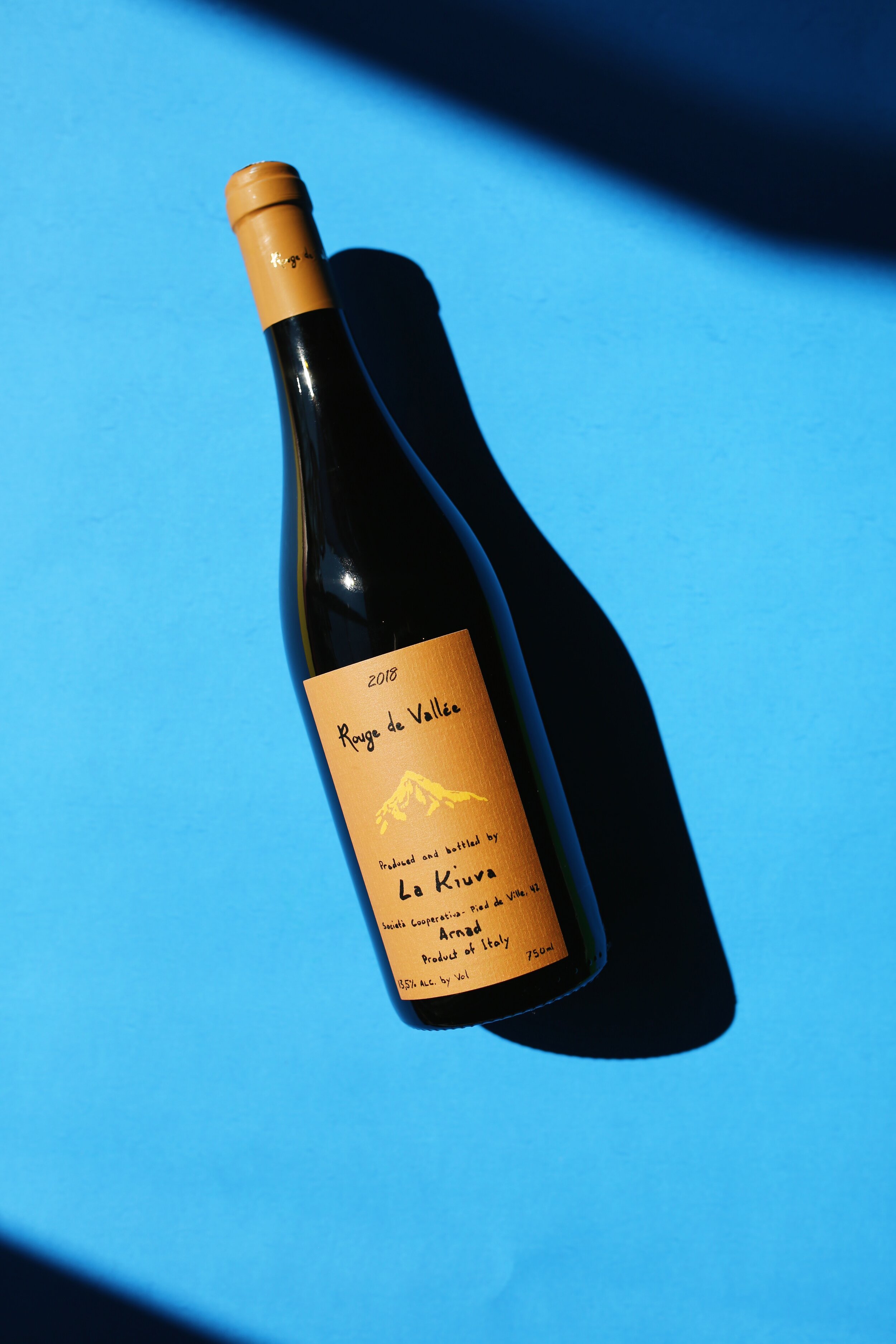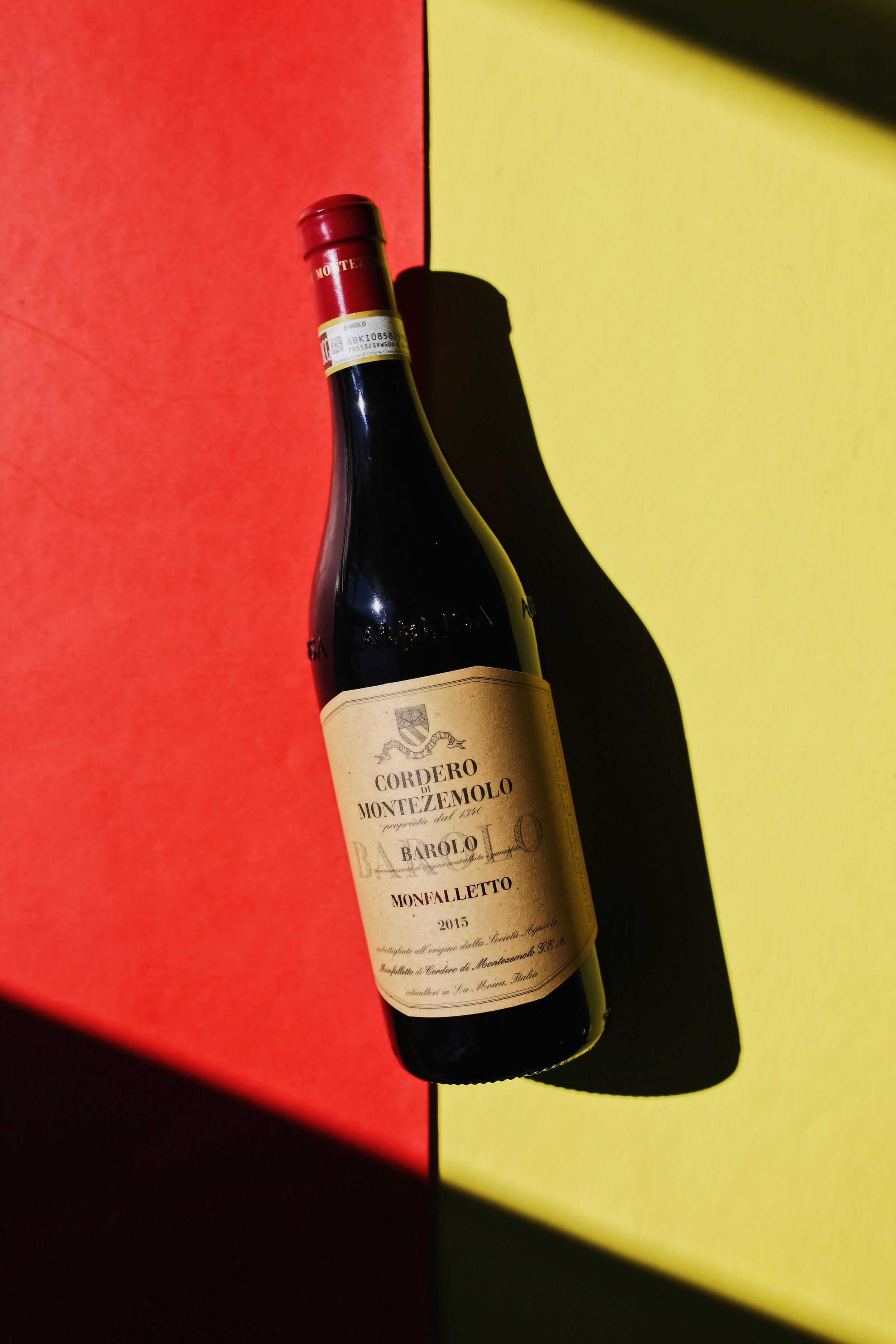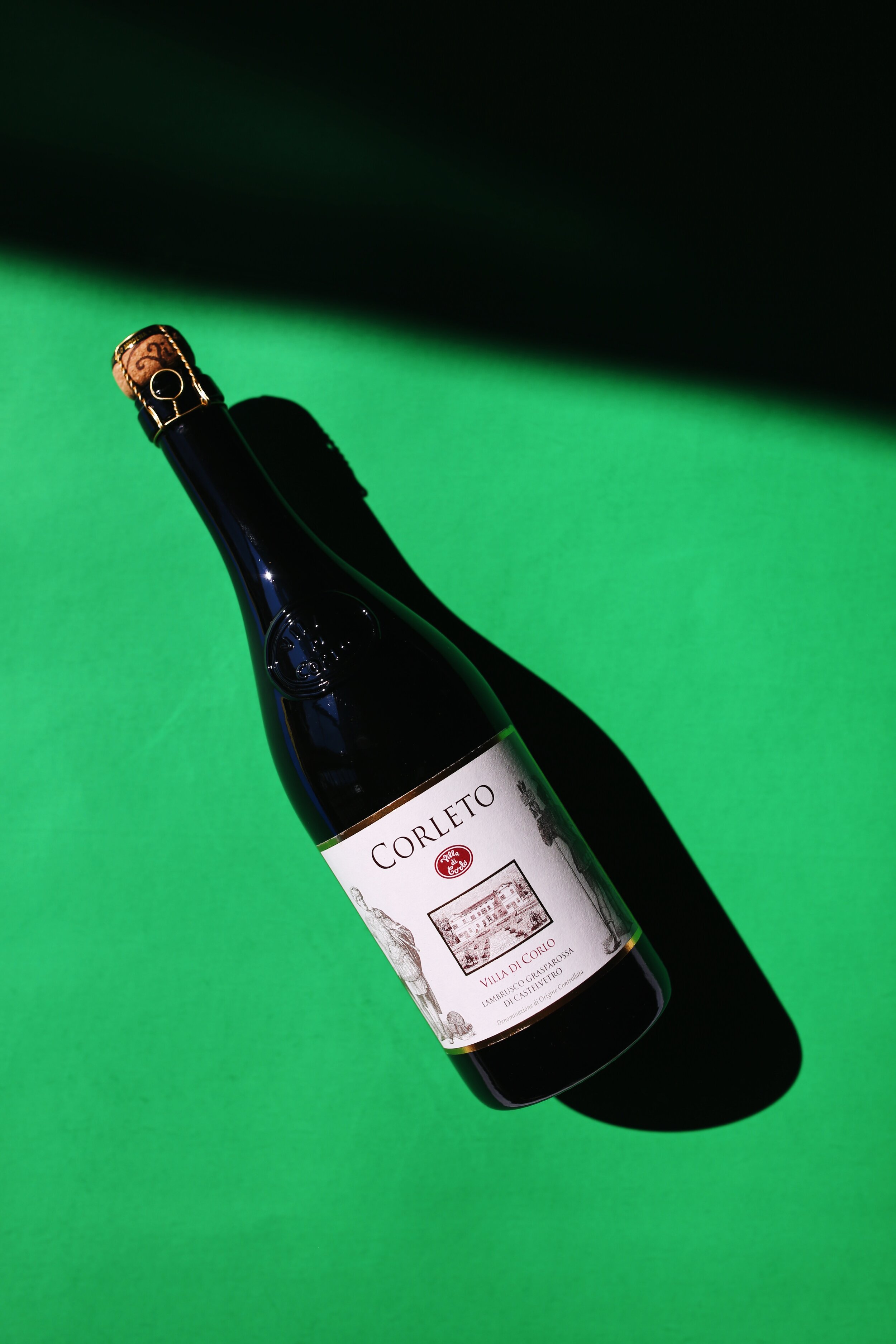The Art of Italian Entertaining
Our dream Italian table featuring hand block printed table lines, vintage wicker chargers, and hand-painted Italian ceramics. All available on our e-shop.
CIAO!
Welcome to Italia! For our next stop along the Mediterranean, we’ll be traveling through the land of la dolce vita, celebrating the art of living, Italian style. We begin our travels not with an Italian destination but a frame of mind—the art of Italian entertaining. We’re intrigued by the question: what makes an Italian dinner so alluring? We set out to discover the elements at play, and then we curated a shop and a guide (below) to help bring the magic of the Italian evening home. Beginning with assembling an Italian table, and moving on to throwing a proper Italian party—with dinner, drinks, and the in between. Our e-shop is stocked with special pieces for the Italian table—from linens to plates and a collection of vintage pieces, as well as Italian artisan pasta, olive oil, balsamic vinegar, and wine. We hope to inspire the sense that traveling to Italy for an evening is not only possible, but is sure to be an experience steeped in magic.
Allora! The Italian dinner party!
Vintage blue and white pieces and hand-block printed table cloths make for a table bursting with color. Shop these objects here.
convivium | the italian dinner
Everything has an origin. The Italian dinner of today finds its roots in Ancient Roman traditions on eating and gathering that took shape 2,000 years ago.
While the Ancient Greeks drank in their symposia, the Ancient Romans ate in theirs. The Roman banquet was called the convivium, meaning living together, a poignant signifier of the idea that gathering around the table to share a meal is about more than food. In fact, the banquet, and attendantly food, was a central characteristic of Ancient Roman culture, religion, and politics.
For the Ancient Romans, the dinner party was a grand and poetic affair. Katharine Raff, of The Metropolitan Museum of Art writes, “Roman literary sources describe elite private banquets as a kind of feast for the senses, during which the host strove to impress his guests with extravagant fare, luxurious tableware, and diverse forms of entertainment, all of which were enjoyed in a lavishly adorned setting.”
In the 1st century AD, Marcus Gavius Apicius wrote De Re Coquinaria (The Art of Cooking). It is the only surviving cookbook of the Roman empire.
A 1st century AD mural depicting a traditional Roman banquette in Pompeii
A fresco from Pompeii circa 50-79 BC. Collection of the National Archaeological Museum of Naples.
a tavola | the italian table
For Italians there is the gioie della tavola, the joys of the table. The Italian table is a sacred place, where food and family, pillars of Italian society, meet, and where life unfolds, casually and communally, over the universal human experience of a shared meal. It is here, at the table, that we set the scene for our dinner party.
First, we retreat to our imagination where images of countless Italian dinner parties dance around in our minds. We’re inspired by the easy old-world elegance of taste makers whose approach to living and entertaining Italian-style is mythical. How would Marella Agnelli set the table for a special evening at her beloved Villar Perosa? What about Contessa Lili Volpi preparing for a dinner party in her Venetian palazzo? We’re invited to Rudolph Nureyev’s seaside retreat in Li Galli, where, according to ancient myth, sirens lived—how does the table look when we arrive? What about at one of Marchesa Luisa Casati’s extravagant dinner parties? At Mona von Bismarck’s in Capri, Peggy Guggenheim’s in Venice, or at Le Sirenuse in Positano when it was still the summer home of the Sersale family—what was the spirit of these Italian tables? Is there a unifying philosophy at the heart of Italian entertaining? And, how do we weave together these stories—of places, parties and people—to arrive at the Italian table of our fantasies?
Antonelli Sisters, Florence, 1983 | Slim Aarons
The bedroom suite of Marella Agnelli at Villar Perosa in Turin, Italy | Image via Architectural Digest
Marella Agnelli at Villar Perosa, 1967 | Horst P. Horst
Peggy Guggenheim (wearing Fortuny!) dining in Venice c. 1950 | photographer unknown
A cocktail party at Peggy Guggenheim c. 1965 © Private Collection/Bridgeman Images
Peggy Guggenheim having breakfast in the Palazzo Venier dei Leoni, c. 1970 | Ray Wilson courtesy Peggy Guggenheim Collection, Venice
Rudolf Nureyev’s villa on Li Galli, an archipelago off the Amalfi Coast | photographer unknown
Rudolf Nureyev at home on Li Galli, circa the late 1980s | photographer unknown
Le Sirenuse, a boutique hotel in Positano that began as the summer home of the Sersale family, who transformed the property into a hotel in 1951.
The Pompeii Red walls of Le Sirenuse | image via Le Sirenuse Journal
For us, the answer was less about a formula and more about a feeling—it is elegant and effervescent at once, polished yet playful, and vibrating with life. Inspired, we set about building our Italian table. Here are its basic elements:
the linens | We begin with table linens in contrasting colors, patterns and prints. For the Italy collection, we selected hand block-printed linens made by an artisanal collective in Jaipur, India. Hand-block printing is an ancient tradition with a remarkable history of craftsmanship. That these pieces were brought to life by hand no doubt infuses our table with spirit. Sets are mismatched to spark a feeling of light-heartedness, spontaneity, and joy.
the plates | Next, the plates. Hand painted in Italy, these porcelain plates merge the traditional and the modern. Mermaids, birds, flowers and fish infuse the collection with whimsy. Manufactured by Bitossi Home in Montelupo Fiorentino, located near Florence in the Tuscan countryside.
the decor | With festive table linens and plates in place, we turn to decor. Lemons, evocative of southern Italy, bring the feeling of long and luxurious summer dinners near the Italian seaside. We accented our tablescape with vintage lemon plates and glass lemons. Yellow and blue drinking glasses further the table’s colorful visual appeal. And last but perhaps most importantly—candles, whose luminous presence and warm glow will cast a spell over the entire table. To bring even more life to the table, we could have included fruits, vegetables and flowers. Artichokes or delicate white flowers such as baby’s breath would have added a lovely organic dimension to our green, white, and yellow spread.
cena | dinner time
“A tavola non si invecchia.”
Dinner on a terrace in Capri, 1980 | Slim Aarons
With the table set, we move to the food. An Italian dinner proceeds in a traditional format of courses, which unfold gradually, allowing for ample time to soak up company and conversation. The history of Italian courses traces back to Ancient Rome, where dinner took place in three stages—the gustatio, or appetizer, usually a variety of egg dish; the primae minsae, the main course often consisting of meat; and the secundae mensae, the dessert, fruit, nuts, or baked sweets. All these centuries later, the Italian meal follows a similar format.
aperitivo | The first stage of the evening is the aperitivo, is an informal opener to the night where guests stand and mingle while people stream in. The aperitivo is a drink and a small bite of food, perhaps olives, cheese or nuts, nothing heavier.
antipasti | Once all of the guests have arrived, everyone is seated at the table for antipasti, which translates to before the meal. This usually cold course is heavier than the aperitivo but not yet dinner—salumi and cheese, sandwiches, smoked salmon and shrimp cocktail.
primi | Next, the first main dinner course. Primi piatti are warm dishes, including pasta, risotto, polenta or soup. This non-meat course provides a natural progression from cold, lighter fare to the heaviest portion of the meal, coming next.
secondi | Secondi piatti, the second main course, is the most substantial of the meal. Here, meat, chicken, and fish are served.
contorni | Customarily served alongside secondi are contorni, side dishes featuring vegetables, served both raw and cooked, as well as salad, which might be served with the cotorni or afterwards.
dolci| With the main course complete, dolci, or sweets, come next.
digestivi e caffè | The final course involves digestivi, after-dinner drinks. The very last element of the evening is caffè—a shot of espresso with no milk, which is considered bad form after a meal.
For our travels to Italy, we’re offering a few specials for your Italian dinner party. For the antipasto course, we are assembling Italian salumi boards and baking garden focaccia. And for the dolci, a dark rum tiramisu cake. We’re also selling an Italian cookbook for the courses in between—Old World Italian by Mimi Thorisson which takes a tour through the dishes at the heart of Italian culture and is a delight for the senses.
Additionally, our e-shop is stocked with olive oil, balsamic vinegar, pasta, and tomato sauce to bring an authentic element to the food you choose to cook for your Italian affair.
bevande | drinks
Drinks at the Italian dinner come in three categories: aperitivi, served before the meal, digestivi, served after the meal, and wine, served with the meal. The aperitivo is a cultural institution in Italy that transcends the act of drinking and speaks instead to the Italian state of mind about deliberate and joyful living. There is ritual in it—a carving out of time before the shared experience of a meal to celebrate and anticipate the event to come. A traditional Italian aperitivo begins around 7pm and ends around 9pm, with the start of dinner. Popular aperitivi include drinks lower in alcohol content: Prosecco (Italian sparkling wine originating from Veneto), Aperol spritz (Prosecco, Aperol and soda water), Bellini (Prosecco and peach puree), and of course the Negroni (equal parts gin, sweet vermouth, and Campari), Italy’s most famous cocktail. Digestivi have the opposite effect, meant to aid in digestion and close the evening. Usually higher in alcohol content, digestivi include amaro, grappa, and limoncello.
With the meal, wine is served. Wine is a deeply rooted aspect of Italian culture, and is produced in every region of Italy from the North to the South. The Greeks and Etruscans cultivated Italy’s first grapes thousands of years ago, but by the 2nd century, the Romans themselves were excelling at viticulture. As a general rule of thumb, Italian wine pairings proceed as follows. Primi piatti, like pasta and risotto are paired with a dry white wine. Secondi piatti are paired with a red wine, with the exception of fish, which is paired with a white. Poultry and lighter meat dishes pair with a lighter red wine, while heavier dishes like roasts pair with a more full-bodied wine.
For our travels to Italy, we selected four wines, each from a different region—Piedmont, Lombardy, Modena, and the Aosta Valley bordering the Alps. You can learn more about our wines here.
la scena | setting the scene
Summer lunch La Pigna in Capri, August 1980 | Slim Aarons
The table is set, the dinner and drinks have been sorted, the final step is to set the scene. Since the earliest days of the Ancient Roman banquet, two things have provided depth and life to the Italian dinner party—table conversation, convivium, and music, which in the form of flute and lyre performances, among others. Dinner conversation is considered as important as the meal itself, as it helps guests to meaningfully connect with one another over the shared experience of food. Conversation takes place during dinner but also after the meal has finished, when it is customary for guests to linger and continue chatting.
Similarly, music is essential to setting the mood for a dinner party. We created an Elephantine Italy playlist on Spotify to bring the sounds of la dolce vita to your Italian evening.
Roman Banquet Scene, 1876 | Pierre Olivier Joseph Coomans
elephantine x italy spotify playlist
Despite the role that sights, smells, tastes, and sounds play in the Italian dinner party, the most important ingredients for a truly memorable evening are not discerned by the senses but felt. The things about Italy that are most transcendent—making time for celebration in a world that is incessantly rushing, clinging to rituals that moor us to culture and community, savoring the smallest of life’s moments—these things are an attitude, a spirit. They’re the starting point for a brilliant dinner party, and the life that envelops it.
Li Galli, date unknown | photo via @placesilove

